
Welcome to losangelessnakes.com! I am David, a snake enthusiast living in Los Angeles, CA. Many people don't know that Los Angeles is in fact full of snakes! You just need to know where to find them - they can often be shy and elusive. Some California snake species are more common outside of the city limits, in different parts of Los Angeles County CA, but many types of snakes are indeed common in the more urban parts of Los Angeles. This guide is meant to help educate you about the beautiful snakes of Los Angeles, and to help you identify the most common snakes of Los Angeles, as well as the venomous snakes of Los Angeles that you should learn to recognize and avoid. If you want more detail, click here for my complete list of ALL snake species in Los Angeles. Remember the following:
- Most snakes of Los Angeles are harmless and don't want to encounter you
- Venomous snakes exist but are uncommon in Los Angeles, California
- Snakes eat rats and mice and are a valuable part of the California ecosystem
- Never kill a snake - if you leave a snake alone, it will leave you alone.
Common Snake Species in Los Angeles
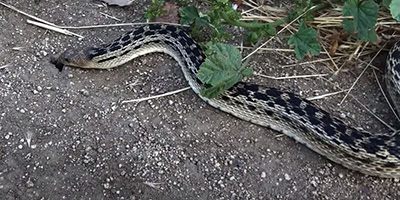 Gopher Snake:
The gopher snake, also referred to as the Pituophis catenifer, is a type of snake endemic to the Pacific Coast and non-dangerous to humans. The gopher snake can grow quite long, reaching up to 7 feet (roughly 213 cm) in length, although most commonly, it doesn’t go over 5 feet (around 150 cm). Its coloring tends to be a muddy brown, sometimes yellowish, and gray on the sides. The gopher snake is spotted, with the spots on its back usually being a dark brown color. They‘re usually active in the daytime and prefer meadows and woodlands. When threatened, they hiss and try to emit a rattle similar to that of the rattlesnake. Its diet consists mainly of small mammals.
Gopher Snake:
The gopher snake, also referred to as the Pituophis catenifer, is a type of snake endemic to the Pacific Coast and non-dangerous to humans. The gopher snake can grow quite long, reaching up to 7 feet (roughly 213 cm) in length, although most commonly, it doesn’t go over 5 feet (around 150 cm). Its coloring tends to be a muddy brown, sometimes yellowish, and gray on the sides. The gopher snake is spotted, with the spots on its back usually being a dark brown color. They‘re usually active in the daytime and prefer meadows and woodlands. When threatened, they hiss and try to emit a rattle similar to that of the rattlesnake. Its diet consists mainly of small mammals.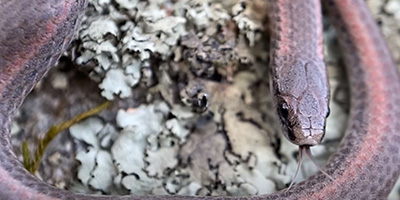 Sharp-tailed Snake:
The sharp-tailed snake is a particularly small kind of serpent, officially known as the Contia tenuisi. Generally, it only grows up to about 18 inches (so less than 50 cm) but has a fairly stout body. Its tail protrudes and is distinctly sharp, hence the serpent’s name. The sharp-tailed snake usually uses its tail to stabilize its prey and make it easier to consume. The sharp-tailed snake is usually a dark reddish-brown on the back, with fascinating black and white crossbands on the ventral area. It’s a deeply shy, sensitive creature and usually burrows and hides. It eats exclusively slugs and slug eggs.
Sharp-tailed Snake:
The sharp-tailed snake is a particularly small kind of serpent, officially known as the Contia tenuisi. Generally, it only grows up to about 18 inches (so less than 50 cm) but has a fairly stout body. Its tail protrudes and is distinctly sharp, hence the serpent’s name. The sharp-tailed snake usually uses its tail to stabilize its prey and make it easier to consume. The sharp-tailed snake is usually a dark reddish-brown on the back, with fascinating black and white crossbands on the ventral area. It’s a deeply shy, sensitive creature and usually burrows and hides. It eats exclusively slugs and slug eggs. 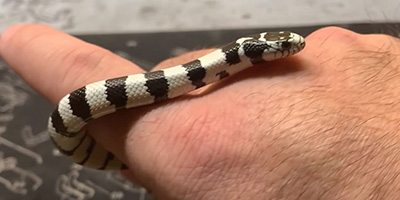 California Kingsnake:
The Lampropeltis californiae is considered one of the best pet snakes, thanks to its docile nature and ease of care. While the color scheme varies, most California Kingsnakes tend to be brown with white-ish stripes. The kingsnake usually measures up to 2 feet in length (60 cm). The California kingsnake is a mostly diurnal creature, that will emit a low rattle when threatened, so as to imitate the venomous rattlesnake. They are considered kings because they’ve been known to eat other snakes, including venomous ones, to which they’re mostly immune.
California Kingsnake:
The Lampropeltis californiae is considered one of the best pet snakes, thanks to its docile nature and ease of care. While the color scheme varies, most California Kingsnakes tend to be brown with white-ish stripes. The kingsnake usually measures up to 2 feet in length (60 cm). The California kingsnake is a mostly diurnal creature, that will emit a low rattle when threatened, so as to imitate the venomous rattlesnake. They are considered kings because they’ve been known to eat other snakes, including venomous ones, to which they’re mostly immune. Venomous Snake Species in Los Angeles
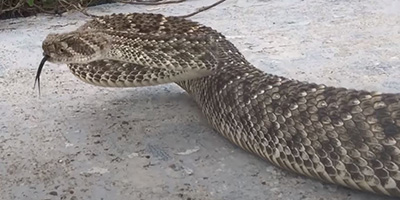 Western Rattlesnake:
Also known as the Crotalus oreganus, the western rattlesnake is a venomous type of pit viper found throughout California. What’s particularly interesting is that it can vary greatly in size, as some specimens are stunted, while others can grow quite large. Typically, it will grow to about 40 inches (or roughly 100 cm). Its colors are usually earthy, various shades of brown, with dark blotches on its back, distinguishable by their white borders. The western rattlesnake uses the heat detectors inside its face to detect prey, which usually means birds and small mammals.
Western Rattlesnake:
Also known as the Crotalus oreganus, the western rattlesnake is a venomous type of pit viper found throughout California. What’s particularly interesting is that it can vary greatly in size, as some specimens are stunted, while others can grow quite large. Typically, it will grow to about 40 inches (or roughly 100 cm). Its colors are usually earthy, various shades of brown, with dark blotches on its back, distinguishable by their white borders. The western rattlesnake uses the heat detectors inside its face to detect prey, which usually means birds and small mammals. 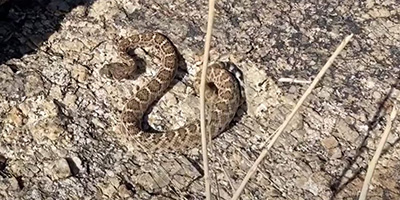 Western Diamondback:
The western diamondback (Crotalus atrox) is a common and quite a dangerous type of snake. It grows, in length, to four feet (or 120 cm), but can go all the way up to 5 feet, in rare cases. Its color scheme is most commonly brownish, although some have been noted to have pink or grayish shades. Its back is marked by thin stripes, with a few of them resembling a diamond in shape, hence the name. The western diamondback feeds on small mammals, and its venom is hemotoxic (meaning it affects the blood vessels of its victim).
Western Diamondback:
The western diamondback (Crotalus atrox) is a common and quite a dangerous type of snake. It grows, in length, to four feet (or 120 cm), but can go all the way up to 5 feet, in rare cases. Its color scheme is most commonly brownish, although some have been noted to have pink or grayish shades. Its back is marked by thin stripes, with a few of them resembling a diamond in shape, hence the name. The western diamondback feeds on small mammals, and its venom is hemotoxic (meaning it affects the blood vessels of its victim).
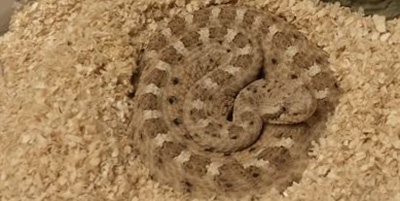 Sidewinder:
The sidewinder (Crotalus cerastes), also referred to as the horned rattlesnake, is a fairly small, but dangerous type of pit viper. Adults usually only measure up to 30 inches in length (75 cm) and tend to have earthy, brown, or gray colors. Its back is marked by scales, even extending above the serpent’s eyes. While still venomous, the sidewinder is less dangerous than other rattlesnakes, because of its fairly weak venom as well as its small size.
Sidewinder:
The sidewinder (Crotalus cerastes), also referred to as the horned rattlesnake, is a fairly small, but dangerous type of pit viper. Adults usually only measure up to 30 inches in length (75 cm) and tend to have earthy, brown, or gray colors. Its back is marked by scales, even extending above the serpent’s eyes. While still venomous, the sidewinder is less dangerous than other rattlesnakes, because of its fairly weak venom as well as its small size.
If you're unsure, you can email me a photo of the snake at info@losangelessnakes.com and I will email you back with the snake's species. If you found a snake skin, read my Found a Skin? page, and you can email me a photo of the skin, and I'll identify the snake for you. If you need professional Los Angeles snake removal help, click my Get Help page, or see the below website sponsor I found, who provides that service.
Remember, the term is not poisonous snakes of Los Angeles, it's venomous snakes of Los Angeles. Poison is generally something you eat, and venom is injected into you. That said, dangerous snakes are very rare in Los Angeles. The few venomous snakes of Los Angeles County are rarely seen. But they are commonly misidentified, so learn about all the snake species of Los Angeles in order to correctly identify them. These snakes are usually also found in the surrounding towns of Santa Monica, Beverly Hills, Long Beach, Malibu, Pasadena, Calabasas, Compton, La Mirada, Glendale, Inglewood, Burbank, Palmdale, Santa Clarita, Lancaster, West Hollywood, East Los Angeles, Torrance, Culver City, Pomona, Whittier, Hidden Hills, El Monte, Norwalk, Downey, West Covina, Redondo Beach, Manhattan Beach, La Cañada Flintridge, Marina del Rey, La Puente, Carson, Hawthorne, Arcadia, Alhambra, Gardena, Baldwin Park, Montebello, San Gabriel, South Gate, Orange, Irvine, Anaheim, Newport Beach, Santa Ana, Huntington Beach, Laguna Beach, Costa Mesa, Fullerton, Tustin, Garden Grove, Mission Viejo, San Clemente, Yorba Linda, Westminster, Lake Forest, Brea, Buena Park, Dana Point, Laguna Niguel, Fountain Valley, Aliso Viejo, La Habra, Cypress, San Juan Capistrano, Rancho Santa Margarita, Coto de Caza, Seal Beach, Laguna Hills, Placentia, Los Alamitos, Ladera, and the surrounding areas.
Read our article about:
How Big Can Snakes Get?
losangelessnakes.com domain and hosting costs made possible by the generous support of this sponsor:
